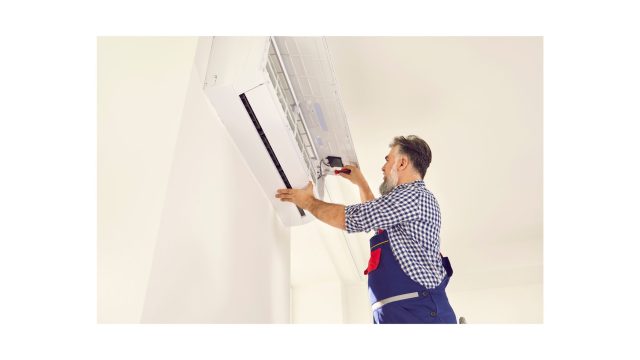In the scorching heat of summer, few things offer solace like the cool breeze of an air conditioner. Yet, the process of installing one can often feel daunting, shrouded in mystery and technical jargon. This blog aims to unravel the complexities surrounding AC installation services, making the journey towards enhanced comfort smoother and more comprehensible. From understanding different types of air conditioning systems to deciphering the intricacies of installation procedures, we delve into every aspect. Whether you’re a homeowner looking to invest in a new AC unit or a business owner seeking to upgrade your establishment’s cooling system, this guide is your compass. Say goodbye to confusion and embrace the clarity as we demystify the world of AC installation services, empowering you to make informed decisions and elevate your
Types of Air Conditioning Systems: Exploring Your Options
When it comes to air conditioning systems, the array of options can be overwhelming. From traditional central air systems to ductless mini-split units and portable ACs, each type has its unique features and suitability for different spaces. Central air systems are ideal for larger homes or buildings, providing uniform cooling throughout the space. Ductless mini-split systems offer flexibility, allowing for independent temperature control in different rooms without the need for ductwork. Portable AC units are perfect for smaller spaces or for cooling specific areas on-the-go. Understanding the nuances of each system empowers you to make an informed decision based on your specific needs, budget, and space requirements.

Understanding Installation Requirements: A Step-by-Step Guide
Ensuring a successful air conditioning installation involves meticulous planning and attention to detail. Here’s a step-by-step guide to help you navigate the process with confidence:
- Assess Your Space: Begin by evaluating your space to determine the most suitable location for the AC unit. Consider factors such as sunlight exposure, airflow, and proximity to electrical outlets.
- Calculate Cooling Load: Next, calculate the cooling load to determine the appropriate size of the AC unit for your space. Factors such as square footage, insulation levels, and the number of occupants will influence this calculation.
- Select the Right Unit: Choose an AC unit that matches your calculated cooling load and meets your specific needs and budget. Consider factors such as energy efficiency, features, and warranty options.
- Follow Installation Guidelines: Once you have selected the unit, follow the manufacturer’s guidelines and local building codes for installation. This includes mounting indoor and outdoor components, connecting refrigerant lines, and ensuring proper insulation and sealing.
- Professional Assistance: If you’re unsure or uncomfortable with any aspect of the installation process, don’t hesitate to seek professional assistance. Experienced HVAC technicians can ensure a safe and effective installation, providing peace of mind and optimal performance.
By understanding and following these installation requirements step-by-step, you can ensure a smooth and successful process, ultimately maximizing the efficiency and longevity of your air conditioning system. Don’t hesitate to reach out to professionals like Best By Farr LLC for expert guidance and assistance throughout the installation journey.
Choosing the Right Size: Sizing Up Your AC Unit
Selecting the right size AC unit is crucial for efficient cooling. An oversized unit leads to frequent cycling, higher energy consumption, and uneven cooling, while an undersized unit struggles to cool adequately. Calculating the cooling load involves factors like area size, insulation, windows, and climate. Professional HVAC technicians ensure accurate sizing, optimizing performance and energy efficiency. Investing in proper sizing means consistent comfort and lower energy bills year-round.
Assessing Energy Efficiency: Maximizing Cooling Performance
In today’s eco-conscious world, energy efficiency is a top priority for many homeowners and businesses seeking to minimize their environmental footprint and reduce utility costs. When selecting an air conditioning system, it’s essential to consider its energy efficiency rating, often indicated by the SEER (Seasonal Energy Efficiency Ratio) or EER (Energy Efficiency Ratio). Higher SEER or EER ratings indicate greater efficiency, meaning the unit can provide the same cooling output while consuming less energy. Additionally, features such as programmable thermostats, variable-speed compressors, and advanced airflow controls can further enhance efficiency and comfort. Investing in an energy-efficient air conditioning system not only reduces your carbon footprint but also saves you money on your energy bills over time, making it a win-win for both your wallet and the planet.
Navigating Installation Costs: Budgeting for Your Comfort
When it comes to installing an air conditioning system, understanding and managing installation costs is crucial for budget-conscious homeowners and businesses alike. Here’s a guide to help you navigate through the process:

- Initial Expense Evaluation: Begin by assessing your budget and determining how much you’re willing to invest in your AC installation project.
- Cost Factors: Understand the various factors that influence installation costs, including the type of system, complexity of installation, and additional upgrades or modifications required.
- Obtain Multiple Quotes: Reach out to several reputable HVAC contractors to get detailed quotes for your project, allowing you to compare prices and services offered.
- Consider Long-Term Savings: While upfront costs are important, also consider the long-term savings associated with energy-efficient systems, which can offset initial expenses over time.
- Discuss Financing Options: Explore financing options or payment plans offered by HVAC companies to help spread out the cost of installation and make it more manageable for your budget.
Navigating installation costs for your air conditioning system doesn’t have to be daunting. By evaluating your budget, understanding cost factors, obtaining multiple quotes, considering long-term savings, and discussing financing options, you can effectively budget for your comfort without breaking the bank. Don’t hesitate to reach out to trusted HVAC professionals for guidance and assistance throughout the process. Your comfort is worth the investment.
DIY vs. Professional Installation: Pros and Cons
One of the dilemmas homeowners face when considering AC installation is whether to tackle the project themselves or hire a professional HVAC contractor. While a DIY approach may seem cost-effective initially, it comes with its share of challenges and risks. Installing an air conditioning system requires specialized knowledge, tools, and skills to ensure proper placement, sizing, and connection of components. Mistakes during installation can lead to inefficiencies, malfunctions, and even safety hazards. On the other hand, professional installation offers peace of mind knowing that trained technicians will handle every aspect of the process with precision and expertise. They can also provide valuable advice on selecting the right unit, optimizing efficiency, and maximizing comfort. Ultimately, weighing the pros and cons of DIY versus professional installation and considering factors such as your skill level, time constraints, and budget will help you make the best decision for your specific needs.
Ensuring Proper Ventilation: Optimizing Airflow in Your Space
Effective ventilation is essential for maintaining indoor air quality and ensuring optimal comfort levels in your home or business. When installing an air conditioning system, it’s crucial to consider factors such as duct design, placement of vents, and airflow patterns to maximize efficiency and comfort. Proper ventilation helps distribute cool air evenly throughout the space, eliminating hot spots and reducing the workload on your AC unit. It also helps remove excess moisture and indoor pollutants, creating a healthier and more comfortable indoor environment. Consulting with a professional HVAC technician can help assess your ventilation needs and recommend solutions such as duct sealing, zoning systems, or air purifiers to optimize airflow and enhance overall comfort and indoor air quality.
Maintenance Tips for Longevity: Preserving Your Investment
Regular maintenance is crucial for extending the lifespan of your air conditioning system and preserving your investment. Here are some maintenance tips to keep your AC running smoothly:
- Clean or replace air filters regularly: Clogged filters restrict airflow and reduce efficiency.
- Inspect and lubricate moving parts: Proper lubrication prevents friction and extends the life of components.
- Check refrigerant levels: Low refrigerant levels can indicate a leak or improper system function.
- Schedule annual professional tune-ups: Professional inspections can catch minor issues before they become major problems.
- Keep outdoor units clear of debris: Debris can obstruct airflow and strain the system.
By following these maintenance tips, you can ensure that your air conditioning system operates efficiently and effectively, saving you money on energy bills and preventing costly repairs down the line. Regular maintenance is key to preserving your investment and enjoying reliable comfort year-round.
Conclusion
When it comes to ensuring your comfort in Cottonwood, AZ, look no further than Best By Farr LLC. With our years of experience and commitment to excellence, we stand ready to address all your air conditioning needs. Whether you require installation, maintenance, repair, or replacement services for your residential or commercial property, our team of skilled technicians is here to provide reliable solutions tailored to your requirements. Located conveniently at 781 Air Park Way Suite #A4, Cottonwood, AZ 86326, you can trust us to serve Sedona & Verde Valley since 1999. Don’t let the heat get the best of you—contact us today at (928) 282-2250 to experience the difference with Best By Farr LLC. Your comfort is our priority, and we’re dedicated to delivering top-quality AC services that you can rely on.


